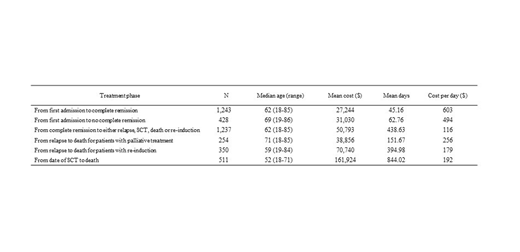Introduction: AML affects all ages with an incidence rate of 5 per 100,000, but is much more frequent in older population. The overall lifetime risk of AML is estimated to be 0.5-1%. Long-term overall survival in younger (age < 60 years) is about 50%, but much worse among older population. Although AML therapy is one of the most resource-intensive cancer treatments, there are few estimates of the resource use and economic burden by treatment phase.
Methods: This study was a retrospective database study performed on Swedish national data. Adult patients (age ≥18 years) diagnosed with AML in Sweden between 2007 and 2015 were identified in the Swedish Cancer Registry, along with vital status. Data on resource use were collected from national registers for inpatient- and outpatient specialized care and prescribed drugs. Information on diagnostics and treatment was accessed from the Swedish national AML Registry (SwAMLR). Data on sick leave (SL) and early retirement (ER) came from the Swedish Social Insurance Agency (absent days costed with the mean salary in Sweden). Hospital care resource use was costed using diagnosis-related group (DRG) remunerations, and include cost of inpatient drugs. The mean cost from the defined start of the treatment phase until the end of the treatment phase was divided by the mean number of days for the corresponding treatment phase to estimate the mean cost per day. The defined treatment phases were restricted to a maximum of 5 years. All costs are represented in US$.
Results: Of the 2,954 patients identified in the Swedish Cancer Registry, 1,772 patients with a median age of 64 years were identified in the SwAMLR as fit for receiving high-dose chemotherapy . Of these, 1,243 were recorded with both curative intent of treatment and dates for achieving complete remission. Mean costs from the first AML-related hospital admission until the date of complete remission amount to $27,244. The mean number of days for the corresponding period were 45.16, resulting in a mean cost per day of $603 from first admission to first complete remission. The corresponding cost per day for patients recorded with curative intent but no complete remission (n=428) are $494. Time was counted from first AML-related admission until 90 days after first admission, or SCT or death, whichever occurred first. Costs after complete remission to either relapse, SCT, death or re-induction (n=1,237) amount to $50,793 for a mean of 438.63 days ($116/day). This treatment phase includes long-term survivors, whereas the costs from SCT, relapse or re-induction are not included. From relapse to death, the total cost is almost twofold for patients with re-induction (n=350) compared to palliative treatment (n=254). Cost per day amount to $179 for patients with palliative treatment and $256 for patients with re-induction treatment, respectively. The cost per day from date of SCT to death (n=511) is estimated to $192, incurred over a long period of time (mean number of days 844.02). The age of transplant recipients ranged between 18-71 years, with a median of 52 years.
Conclusions: Costs of AML up to remission are feasible to estimate through DRG-costing methods, and studies have shown these costs are intense. Indeed this study shows that the highest cost per day is observed from first admission to complete remission. In addition results from our study show that there are high costs incurred also in the long-term, i.e. after remission. Of the included treatment phases the total cost from date of SCT to death is the largest, amounting to over $160,000. Approximately 20% are due to SL/ER, which is the second largest cost component after inpatient costs accounting for 60% of the total costs.
Hernlund:ICON: Employment. Redig:ICON: Employment. Paulsson:Novartis: Employment. Vertuani:Novartis: Employment.
Author notes
Asterisk with author names denotes non-ASH members.


This feature is available to Subscribers Only
Sign In or Create an Account Close Modal